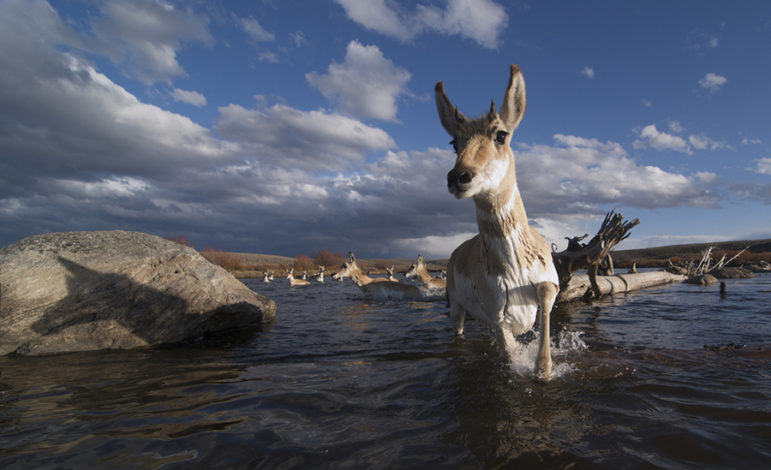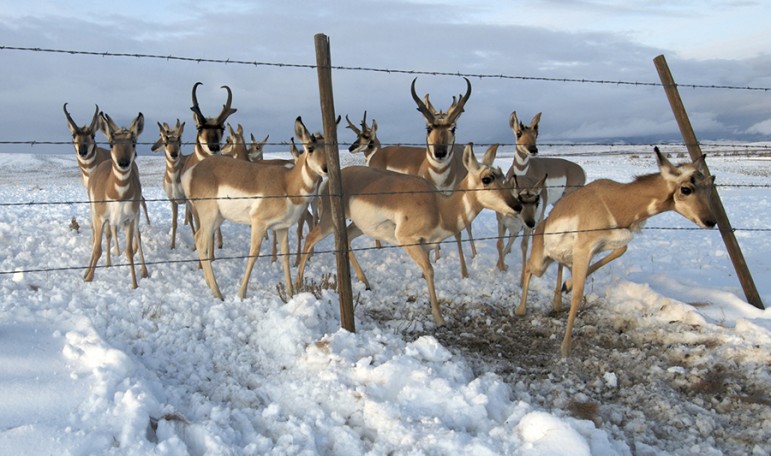
Twice each year in Wyoming, more than 300 pronghorn antelope travel 120 miles ore more, moving from summer grounds along the Snake River in Grand Teton National Park to winter range in the Upper Green River Basin.
The so-called “Pronghorn Passage” has attracted widespread attention as an example of the need to protect wildlife migration corridors as development continues to encroach on ancient routes used by a wide range of animals.
Starting next month, the Buffalo Bill Center of the West in Cody, Wyo. will host an exhibition documenting how pronghorn use the 6,000-year-old route, which is one of the longest land migrations in North America.
Pronghorn Passage, a special exhibition opening Dec. 1 at the Center, tells the story of the migration, its perils for the animals, and recent steps taken to protect it in ways compatible with encroaching development, according to a statement released by the Center.
The core of the exhibition is the large-format photography of Joe Riis, a National Geographic Young Explorer who has retraced on foot the pronghorns’ migration. Riis, a biologist and wildlife photographer, was recently awarded, along with Dr. Arthur Middleton, the inaugural Camp Monaco Prize to fund a project studying elk migration.
Using remote cameras to capture many of the images, Riis set out to spread awareness of the importance of the migration as well as the obstacles the pronghorn face during their journey.

“The photography in Pronghorn Passage is spectacular, but the story of this epic migration is even more exciting and inspiring,” said Charles Preston, curator of the Center’s Draper Natural History Museum.
The swift and elusive animals have long been hampered by a difficult highway crossing at Trapper’s Point, near Pinedale, Wyo., along part of their migration route that spans more than 100 miles.
But scientists with the Wildlife Conservation Society observing the fall pronghorn migration this year have seen the animals successfully using new overpasses and corridors, according to a statement released by the group.
Now in its second year of use by wildlife, the Trapper’s Point overpass was built to make it safer for the cautious pronghorn to cross busy U.S. Highway 191, where vehicle collisions had previously taken a grim toll on their spring and fall migrations.
Researchers found the pronghorn more at ease this fall in making the trip across the Trapper’s Point overpass and at other spots in a corridor of crossings designed to ease their travel.
“While it was great to see pronghorn first using the overpass last year, it was clear that the fences and structures were confusing to them,” said WCS Northern Rockies Program Coordinator Jeff Burrell.
“This year, groups numbering from 100 to 200 moved along a new route directly to, and over, the overpass with no delays,” Burrell said.
The overpass at Trapper’s Point is one of eight special wildlife passages constructed by the Wyoming Department of Transportation along a 13-mile stretch of highway. Sections of eight-foot high barrier fencing were placed along the highway to channel animals to the crossing points.
“Wildlife is an important part of our western heritage, and as we continue to change our world, we create new challenges for wildlife,” Preston said. “Pronghorn Passage shows that we also have the ability to find solutions to help wildlife overcome some of those challenges.”
Contact Yellowstone Gate at 307-213-9818 or [email protected].
